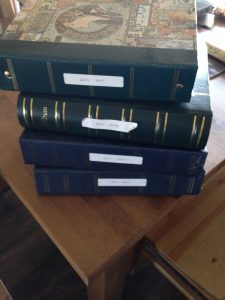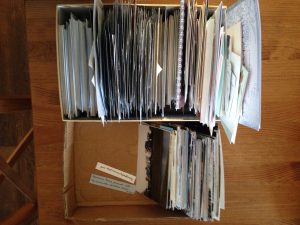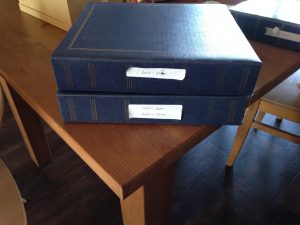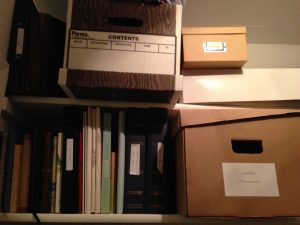The third part of my sentimental category is photos. These include both physical and digital photos. I started with several 3-ring binders, as well as some other albums that were gifts. Here are the binders, which contained all my photos from birth until just before getting married.
What was interesting about these is that I put them together just over a year ago, a huge undertaking. I had read The Life Changing Magic of Tidying Up already at that point, and was trying to apply the joy principle to my selection of photos. Well, I don’t know what I was doing, because this time, I discarded about 50%. That’s 50% of a set of photos that had already made it, supposedly, past a joy check only a year ago. It must be true what Kondo says, that doing the whole KonMari method, in order, really does produce a change in mindset, because this time I obviously looked at these same photos quite differently.
My mistake, last time, was that I looked for pictures to discard: I looked for ones that were blurry, bad, duplicates, or maybe boring or that seemed excessive. But I didn’t do what Kondo recommends, which is to pick and choose what to keep. And not merely the photos that are ‘good’, but the ones that speak to you, inspire you, and are most strongly evocative.
I encountered a problem. In selecting photos to keep, I noticed that in some cases, I had a whole set of photos of an event, of which none gave me joy. What I realised was that perhaps, deep down, there was nothing I cared to memorialise about the event itself. Not that I hated it, just that it no longer inspired me or seemed important. I had often tried to select the best photo of an event, but never stopped to consider whether the thing itself mattered to me enough to document. In some cases, it was clear that the event really ‘belonged’ to someone else – it was someone else’s wedding, someone else’s baby, etc. I was there and snapped a picture, but it wasn’t really part of my own life story.
I have learned a liberating lesson. It is this: I am not responsible for telling the story of anyone’s life but my own. What I was seeing was a collection of photos telling all sorts of stories that were not mine to tell – photos of people I didn’t know, or the baby photo given to me by someone I knew just briefly, or photos taken by other people of events I didn’t attend. I’ve spoken before about the emotional energy required by belongings, and I was finding that these photos exerted an emotional pull on me. It was like being in a room crowded with people I only vaguely knew; there was a lot of social noise, as it were.
I asked myself, ‘What is the purpose of these albums?’ Their purpose is to tell the story of my life. I started looking for photos that told the story of my own life and the things that were important to me. In the process, not only did many events get left aside, but even plenty of photos of people I knew and loved were discarded – not because I don’t love the people, but because it’s not my job to document their lives.
What did I keep? I kept photos that gave me joy to look at and that told what I feel is my own story: many informal photos; some technically ‘bad’ photos of an off-centre room but which remind me of a time and place; and photos which reflect my own impressions and memories, rather than the objective circumstances of an occasion. Of course there are photos of other people, too, but just the ones that really remind me of how they entered my life, and the time I spent with them.
Here are the photos I ended up discarding (along with some other cards and papers).
You know what happened when I reassembled my albums?
Well, first, there were only two.
But second, I look like an awesome photographer who had an awesome life. Obviously, that’s because it’s only the best photos that I kept, and the formerly four-volume narrative now moves at twice the pace.
But then there loomed the beast of digital photos. I took Kondo’s recommended approach here, and created new folders to drag chosen photos into, picking and choosing only what to keep and then deleting the folder’s original contents. Honestly, this took me days and days, and partway through I got bogged down and discouraged. I took a little break and reminded myself why I was doing this in the first place (to enable me to actually enjoy those photos, not fear them; and to free my energy for more important things).
Periodically I emptied the Trash folder on my computer, and tallied up its contents each time. I totalled 6,495 photos deleted.
Then came videos. I didn’t have many until having a baby last year, when the videos exploded. Going through these also took forever.
Finally, I went through other digital sentimental items, including some of the personal folders of my email accounts and a few memorabilia-type documents. By this time, all the emails I’d carefully hoarded over the years failed to spark much attraction for me, and I happily deleted most. All I did was hunt down a few particularly sweet ones I remembered, to save them.
And that, my friends, was that. Sentimental items, all gone through; and the whole KonMari decluttering process, done. It was a little anti-climactic, finishing by deleting emails. I felt that the project was finishing ‘not with a bang, but a whimper’.
It’s a very strange feeling, actually, knowing the precise limits of my memorabilia. It’s like… like a source of exuberant unease has been put to rest; all is quiet. I’ve lived my whole teenage and adult life with memorabilia stuck in every possible corner, and so mixed with other things I could never be guaranteed that I was finished organising it. To be honest, I don’t really know what to do with it now that it’s tidy. It has dawned on me that a primary way that I relate to my belongings is by organising them, over and over: trying a different binder or a different system, or a different criteria for discarding, or putting this box here and moving that one there…you know what I mean. What will I do with my memorabilia when it doesn’t need reorganising? Maybe I’ll just sit and look through it once in a while.
Here is the memorabilia section in the closet. It contains all my old toys, mementoes, journals, albums, and precious papers. The only thing not here is my wedding dress, which I intended to sell after the wedding – but when I found it again (having never sold it), it just made me happy – so I’ve kept it for now.
What next? Well, the KonMari method does include a second phase, which is organising. So I want to look at certain spaces and consider whether they could be better arranged. However, there aren’t any disaster zones; and when things are pared down, the details of organising seem less important. I doubt that I will do any huge overhauls. However, I do also want to return to share some reflections on this whole process and how it has changed my outlook, because that was one of my initial goals.
If you’ve stuck with me this far, thank you!




One thought on “Konmari: Photos, and The End”